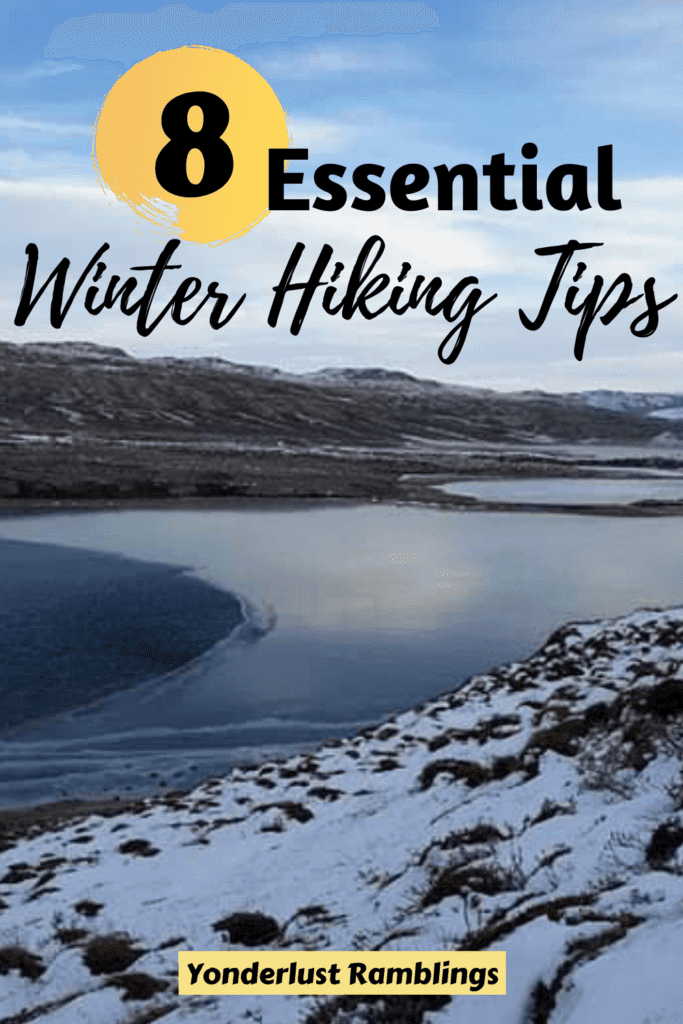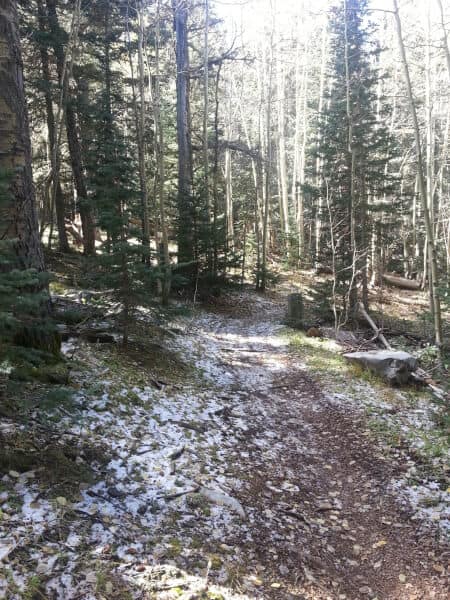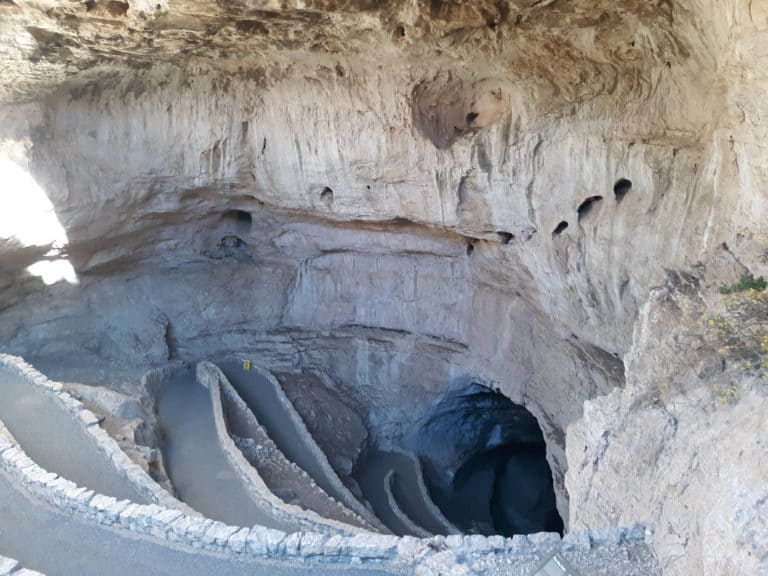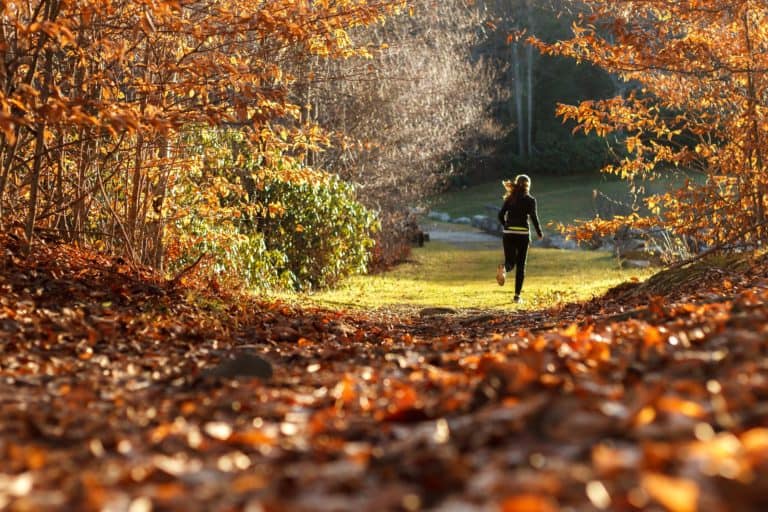8 Essential Winter Hiking Tips: Embrace Hiking in Cold Weather!
Now there is no reason to let the season limit your time in the outdoors! I know a lot of people shy away from winter hiking during the cold months of the year, because hiking in winter in the freezing temperatures can be intimidating! With the right game plan though, you no longer have to give up hiking in winter! Winter hiking can be one of the most beautiful seasons all year to take on some trails, so do not miss out! Learn the proper materials to wear, the correct process for layering, the essential winter hiking gear, and additional winter hiking tips to have a successful cold weather hike! Who knows, maybe winter will even become your favorite season to hit the trails!
Disclosure: Below are some affiliate links-these are all products I highly recommend. I won’t make any recommendations on this page that I haven’t tested or personally used! Enjoy this guide to the best winter hiking tips for hiking in cold weather!
Table of Contents
the 8 Essential Winter Hiking Tips
- #1: Wear the Proper Clothes
- #2: Layer Properly
- #3: Get the Necessary Winter Hiking Gear
- #4: Plan Your Hiking Timeframe Carefully
- #5: Care for Temperature Sensitive Items
- #6: Have a Backup Heat Source
- #7: Pay Close Attention to Your Surroundings
- #8: Bring the 10 Hiking Essentials
Download your own Hiking Essentials Checklist HERE!
#1 Winter Hiking Tip: Wear the Proper Clothes
When I say proper, I really mean only one crucial thing: no cotton! Cotton is a winter hiker’s worst enemy. To be honest, cotton is any athlete or active traveler’s worst enemy in any season, as there are much, much better alternatives to wear, even in summer. But back to winter hiking…
I have heard people say they do not sweat that much, so cotton is not that bad for them. The thing with cotton and hiking in winter though, is that it is not just about the amount you sweat, or your general comfort in cotton. When temperatures plunge below freezing or into the negatives, even a little bit of dampness and moisture can not just be uncomfortable, but dangerous.
Cotton traps heat, without allowing it to be conducted out effectively or safely. What happens when you wear cotton, is the heat and subsequent moisture that your body emits when it is active warms up and becomes trapped under that cotton layer. Because cotton cannot vent properly, that heat and moisture essentially become an internal condensation situation waiting to happen. That trapped moisture and heat turn clammy, right up against your skin. Clammy anything against your skin, when you are hiking in cold weather, can be a potentially dangerous situation, and needs to be avoided. This is where wearing the proper clothing for winter hiking comes into play.
So we have determined what NOT to wear when hiking in cold weather, so what is the best clothing to wear then? My simple, straightforward answer is wool.
There are other great alternatives too, such as fleece and other synthetics. But based on my own personal cold weather active travels, which include winter hiking, high elevation mountain summiting, running half marathons in Greenland in sub zero temps, and road cycling training on gusty November evenings. I even got lost overnight once in the northern Utah Uintas at 12,000 feet, and let me tell you, you will never be more thankful for the right hiking clothing as you will if you ever have the unfortunate experience of spending a cold night alone on the trail without shelter! It is moments like those that really teach you the importance of wearing the right clothing for hiking in cold weather, as well as having a properly stocked 10 essentials hiking inventory!
As I mentioned before, there are several effective materials you can wear for a happy experience hiking in cold weather, such as wool or fleece. For the purposes of this piece though, I am going to give my expert opinion based on what I personally know and use, and what I personally believe is the best material to wear for hiking in winter, and that is wool.
What makes wool the best out there? Wool has several key advantages to hiking in the cold:
#1: It is a very effective insulator of heat. It will take that heat that your body produces and turn it into a comfy warm layer.
#2: The second thing that wool does is arguably the most important. It takes that nice comfy warm layer of heat from your body, and conducts it before it has a chance to condensate and get cold and clammy against your skin. I refer to this as moisture-wicking.
Wool is an amazing material, because it performs this delicate balancing act beautifully. It does the double duty of insulating, while conducting and venting away that condensation and moisture from your body. Wool will keep you comfy and dry.
What are the other reasons I love wool so much? It is super comfy, and that never hurts. Sometimes I am amazed that a material that is as technical and hard working can be so soft and comfortable. My wool leggings are one of my favorite things to wear whether I am hiking in cold weather, or just lounging around the house. I would live in them if I could.
When compared to other inferior materials ( I am talking about you cotton ), wool is a very quick drying material. As you can imagine, this is a great benefit when hiking cold weather. Nothing, not even wool, is completely 100% impervious to moisture. If you hike up Mt. Whitney for twelve hours in the winter, you will encounter some moisture, even in wool. But wool deals with this by being one of the quickest drying materials out there. Another way that it effectively staves off dangerous internal condensation situations.
Wool also has the unique ability to fend off odors, which is a great bonus to a material that is going to be worn aggressively by hikers or any other active traveler. A material that can stand up to sweat and not smell is a miracle in my book.
I have hiked all day in wool, and not smelled at the end of the day. I have run a half marathon in wool, and worn the same wool layers out later that evening, because they did not smell. And remember how I mentioned earlier that wool is a quick drying material? Not only does this prevent dangerous condensation from lingering internally against your skin, but it helps extend the life of your wool clothing. If you are like me, you can wear your wool clothing out winter hiking during the day, and even if it does encounter a smidge of moisture, it will have dried by that evening and you can wear it out again for dinner!
#2 Winter Hiking Tip: Layer with the Proper Clothes
So now that we have established WHAT to wear for winter hiking in the cold, HOW do you wear it? The answer to that question is you wear it in LAYERS! Insulating, moisture wicking, quick drying, move-able, flexible, weatherproof layers! There is a delicate art to layering for a cold weather winter hike, and I will explain all the steps here, starting from the inside out.
But before I address the proper way to layer (in wool of course), I will answer one looming, common question I hear frequently:
If I wear a big, heavy duty winter jacket as my outer layer, does it really matter what I wear underneath?
Simply put, yes, it does, because each of my layers in my three layer system for winter hiking performs its own task and its own job. Your layering system is not complete without all three of your layers. A big heavy jacket on the outside does not compensate for a lackluster base layer. Besides, who wants to hike in a big heavy jacket that limits your movements and mobility while hiking? Wouldn’t you rather hike in the right layers, ones that move with you and enhances your mobility, not limits it? All while accomplishing the multi-purpose tasks of insulating, moisture-wicking, quick drying, and weather-proofing? This is why layering properly is so important for hiking in winter.
We have established that there is a layering process, and my recommendation is to stick to a three part layering system for hiking in cold weather. It should be no surprise that my recommendation for layers is to invest in wool layers. So now for the outline!
- What exactly are the 3 layers?
- What does each layer look like, and what job does it perform?
- And the fun part, picking out your own layering recommendations for winter hiking!
By the time you finish reading this, you will be ready to take on your own winter hiking! No more letting the season limit your time in the outdoors!
3 Part Layering System for Winter Hiking
The 3 parts of your layering system are, in order from inside out, a base layer, mid layer, and outer shell top layer.
Base Layer for Winter Hiking
Your base layer is the foundation from which proper insulation and moisture wicking begin. This is the layer that directly touches your skin, so its effectiveness is key. A base layer’s job is to create an initial cushion of warm, insulating air directly utilizing the emitting body heat.
It also has an important role in quickly and efficiently wicking away any developing moisture. A wool base layer is the best in this role. As you invest in your own base layers, you will notice that base layers for both tops and bottoms often come in ultra lightweight, lightweight, and midweight. For winter hiking, a lightweight base layer is optimal. I will discuss more regarding midweight layers when I get to mid layer tops and bottoms.
Base Layer Tops for Winter Hiking
My go to brand for winter layering is IceBreaker’s BodyFitZone line. Their wool layering tops come in ultralightweight, lightweight, and midweight, depending on the expected degree of cold on your winter hiking trek.
- Women’s BodyFitZone Ultralightweight Base Layer Top
- Women’s BodyFitZone Lightweight Base Layer Top
- Women’s BodyFitZone 260 Midweight Base Layer Top
Base Layer Bottoms for Winter Hiking
Since your legs will generate a lot of heat during your winter hiking, it is more often than not sufficient to wear one base layer underneath an outer shell layer for bottoms. IceBreaker again is my go to brand for winter bottom layers. Here are both ultralightweight and midweight layering options from the BodyFitZone line, with their current prices on Amazon.
- IceBreaker Women’s BodyFitZone 150 Zone Ultralight Base Leggings
- IceBreaker Women’s BodyFitZone 260 Zone MidWeight Leggings
Mid Layer for Winter Hiking
The mid layers job builds on the base layer, and takes it one step further. It must also insulate and wick. The mid layer builds a second insulating cushion of warmth on top of the base layer’s. Though this layer does not directly rest on skin, it must still efficiently wick moisture away that might be developing underneath.
Mid Layer Tops for Winter Hiking
Find my preferred middle layering top from IceBreaker’s BodyFitZone line of wool base layer products, listed at its current Amazon price.
Mid Layer Bottoms for Winter Hiking
This midweight legging from IceBreaker can be used in conjunction with another lightweight legging underneath, or standing alone as a single base layer underneath the outer shell.
Outer Shell Top Layer for Winter Hiking
The outer shell top layer is the final layer in my three part layering system for winter hiking. The outer shell layer does everything the two layers underneath it does, with one important additional task. It must be weatherproof. Your outer shell layer is your first line of defense against external elements, whereas your two inner layers underneath are your first line of defense against internal elements.
When I say weatherproof, I mean that your outer shell layer should have defenses against moisture and wind. You need to look for materials that have been treated to defend against water, and items of clothing that have wind resistant abilities.
One other important thing to consider is the comfort and flexibility of your outer top layer. Since you are preparing for winter hiking, you need a outer shell layer that allows you the flexibility and freedom for the type of mobility that winter hiking calls for. This flexibility factor leads into the comparison between hard shell and soft shell outer layers.
Hard Shell Versus Soft Shell Outer Layer
The difference between hard shell and soft shell outer layers is somewhat what it sounds. Hard shells traditionally have a “harder” feel to them. To me, I equate this to a certain level of stiffness and rigidness, although they are very effective of doing their job in the weatherproofing, insulating, and moisture wicking department.
Personally though, I prefer a soft shell outer layer. I do so because I prefer the “softer”, more flexible and move-able feel of a soft shell. It allows me to more naturally perform the type of physical activities I plan on doing, including winter hiking. Soft shell technology has greatly improved over the years, to where they are now equally adept at providing weatherproofing capabilities.
Both recommendations listed below are excellent at protecting against the elements. I have listed a slightly more minimal water resistant and wind resistant option, for climates where heavy precipitation is not expected, and a full duty waterproof and wind resistant option for full protection against any form of precipitation.
Water Resistant and Wind Resistant Soft Shell Outer Layer
Waterproof and Wind Resistant Soft Shell Outer Layer
And don’t forget an outer shell layer for your legs!
Layering Your Extremities for Winter Hiking
While the focus is often on the major body layers involved in winter hiking, it is important not to forget about protecting your extremities, including your head, neck, face, hands, and feet. When it comes to winter hiking, the goal should be to minimize the amount of skin that is directly exposed to the elements. The less the better, and that is where all of these accessories come into play. If used properly, you should have no significant amount of skin exposed to the cold.
Hat Layer for Winter Hiking
When hiking in winter, I use no less than a two layer layering system for my head. Often , I combine my beanie, Windstopper headband, and Buff to use a three layering system, but more on that later. It is crucial that you layer on your head, in order to maintain precious body heat. My two layering go to’s for my head are a Gore Windstopper band and a SmartWool beanie.
I rely heavily on my Gore Windstopper band as my first layer. I discovered the Gore brand when I started training for my first big road cycling event. This brand is renowned amongst cyclists, who encounter their fair share of gusty rides, no matter what the season. This headband eliminates the cold around my ears, and is my first layer of protection for my head and ears while hiking in winter.
Secondly, I always top off my Gore Windstopper band with a SmartWool cuffed beanie. I prefer the cuffed beanies, because it feels like an additional layer of protection around my ears. And choosing a SmartWool beanie continues the use of wool, my preferred material. This simple beanie is a great conductor of heat, while preventing moisture buildup.
Buff for Winter Hiking
If you were to ask me what my most valued and beloved item of winter hiking gear I have discovered is, I would tell you it is a Buff. Buffs are so versatile, you can call them neck, face, and head layering items simultaneously. They are comfortable, flexible, and stretchy.
You can leave your Buff just around your neck. You can pull it up over your head and ears as another head layer. You can even pull it up over your mouth and or nose to use as a baklava when you need to protect your face from the elements. It accomplishes so many jobs, while being a good insulator and moisture wicker as well. And the best part is, they come in so many different styles and colors, they may just be the most fun item to pick out!

Gloves for Winter Hiking
The gloves you choose are an essential protective piece of winter hiking gear, and therefore need to be rated for cold weather and temperatures, as well as be cell phone friendly, responsive, and user friendly. I love North Face gloves, both the “fuzzy” Denali option, or the Etip traditional option.
Socks for Winter Hiking
The best socks for hiking in winter come from Darn Tough. Of course they are wool, which means that they will keep your toes warm and dry and prevent moisture build up. This last thing is especially important for your feet, because a moisture-wicking sock also stops blisters from forming.
Boots for Winter Hiking
The key thing about this item of winter hiking gear is that it must be waterproof. Your winter hiking footwear must also possess excellent traction and a degree rating below freezing is crucial. I prefer a boot with taller ankle and leg extension, to help prevent snow and ice from getting into my boot, and also for a little extra stability.
I will admit that living in Texas has limited my experience with cold weather specific boots, but when it comes to hiking boots in any weather, I trust the Vasque brand. I have been a loyal all seasons hiker in my Vasque Breeze GTX III boots, and for snowy, icy hikes, I transition over to the Vasque Coldspark Snow Boot.
They are purposefully crafted and treated to be waterproof, breathable, insulated, and come equipped with a specially designed sole compound to withstand winter hiking temperatures. I trust the grip and stability of the Vasque brand. This brand has gotten me to the top of state high point hikes such as Wheeler Peak in New Mexico, King’s Peak in Utah, and Humphrey’s Peak in Arizona.
#3 Winter Hiking Tip: Other Top Winter Hiking Gear
In addition to layering for your body and protecting your extremities, there are a few other pieces of winter hiking gear that will make your escapades on the trails more enjoyable and successful in winter!
Polarized Sunglasses for Winter Hiking
This item of winter hiking gear may be underrated, but it can play a significant role based on your surrounding. Your eyes need protecting too, not just from the sun, but from the glare off of the sun on that stark white snow and ice you may encounter while winter hiking.
Gaiters for Winter Hiking
I actually discovered the ingenuity and genius behind these winter hiking gear while enjoying one of the many fun outdoor opportunities in El Paso, trail running! I used gaiters then to keep the dirt and dust of the trail out of my running shoes then, but they perform the same task for snow and ice that you may encounter while hiking in winter. Pop on a pair of gaiters over your hiking boots, and they will add an extra layer of protection from ice and snow getting inside your boots, because there is nothing worse than a soggy pair of socks when winter hiking.
Shoe Spikes for Winter Hiking
This is an important piece of winter hiking gear if your trail may contain sections of hard packed snow, ice, or permafrost. I will admit, picking out and using a pair of shoe spikes intimidated me at first. They look pretty gnarly, and there is no way to predict what it feels like to hike around in long spikes attached to the bottom of your feet! But after some successful uses, I can easily see the benefit of them, and they are not as awkward to use as they may initially appear.
The best brand from which to purchase this piece of winter hiking gear is Kahtoola. Kahtoola uses stainless steel in their spikes. Make sure to invest in a pair of Microspikes over Nanospikes, as the Microspikes version comes with longer spikes. These spikes do not just add traction, they grip and latch onto ice, frost, and hardened snow. They are flexible, and easy to put in place over your boots.
If you ever want to experience the true confidence boost of a pair of spikes, try running a half marathon over the ice cap in Greenland, and you will realize just how reliable a pair of these spikes are. Total stability, which means you can confidently hike anywhere you want this winter. You no longer have to let a little ice stop you!
Trekking Poles for Winter Hiking
I do not always hike all seasons with trekking poles, but in snow, ice, or other combinations of challenging environmental conditions, they can be quite a handy piece of winter hiking gear for helping to determine the stability of the ground you are covering, as well as helping to maintain balance.
#4 Winter Hiking Tip: Plan Your Hiking Timeframe Carefully and Intentionally
It is always a good rule of thumb to start hiking early, to allow yourself sufficient time in the day to finish your hike. This is especially true if you are hiking in high elevation or on summits, as afternoon storms are a common occurrence you will want to avoid, which means descending early in the day.
Allowing yourself enough time and planning your hiking timeframe intentionally is even more important in the winter, because of the lessened daylight hours that occur during this season. This winter hiking tip may equate to an earlier starting time, in addition to allowing yourself enough “bubble” time to complete your hike.
It never hurts to plan for the worst case scenario as well, so when hiking in winter, plan to bring a headlamp in case your hike gets delayed and you run out of daylight. One of the most important winter hiking tips is do not get stuck hiking at night in the winter without this important item of winter hiking gear.
Get a headlamp like the one listed below on Amazon. Black Diamond is a leader among trusted headlamp brands.
#5 Winter Hiking Tip: Care of Temperature Sensitive Items
You may not think about it, but some things are more temperature sensitive than others. For example, I often bring energy gels with me when I hike, or run, outside in the winter. I have to keep these items close to my body in order to prevent them from freezing.
The best way I have found to do this is to pack those items in a transportation system that I can keep close to my body. I choose to use a FlipBelt, which I can wear around my waist, close to my body heat, under my top layer. This could also work for other cold sensitive items you may wish to bring on your winter hike, such as batteries, or your cell phone. I know my cell phone starts to lag when the temps drop.
#6 Winter Hiking Tip: Have a Backup Heat Source
Even in freezing winter temperatures, if your body is layered properly, the warmth it emits from activity will sufficiently keep you warm. However, one of the wisest winter hiking tips is to plan a backup heat source for hiking in cold weather. Hand warmer and toe warmer packets are a good option, and they are small, compact, and easy to pack along to boot.
#7 Winter Hiking Tip: Pay Extra Close Attention to Your Trail Surroundings
Winter conditions have a way of making trails a little harder to distinguish. A fresh blanket of snow can easily disguise the path, making it harder to follow. It can also disguise obstacles, such as protruding objects or divets in the ground along the path.
Pay close attention to your surroundings. Take note of landmarks, turn around often and observe how the trail looks in reverse. Be mindful that winter conditions make the trail itself less reliable, and trust your other instincts. For these reasons, it is also highly recommended to invest in reliable navigational tools, from compasses, to topographic maps, to phone apps and personal beacons. I include several examples, from basic to high tech, in my own hiking 10 essentials checklist.
#8 Winter Hiking Tip: Bring the 10 Hiking Essentials
This is true in any season. But even more so in winter for your own survival in a worse case scenario. Get an in depth breakdown of the 10 hiking essentials checklist for any winter hike, including what necessary items of winter hiking gear to bring along for shelter, navigation, water, gear, medical supplies, food, and more!
The thing about the ten hiking essentials is that you will more than likely never encounter a winter hiking experience that requires you to dip into your stash of all ten categories. But you will be glad you have them if you ever need them!
Like I mentioned before, I have had my own botched hiking experiences in which I was unfortunately under-prepared. You can learn about the importance of the ten essentials from one hiking experience gone wrong, or from a series of successful hiking experiences, but it is the botched ones that get the lesson across most succinctly! I have had the pleasure of experiencing both, and it has fortunately made me a better hiker and better active traveler in general.
So, now you are ready to hit the wintry trails, fully equipped with the right winter hiking tips and winter hiking gear! If you are looking for some bonus hiking tips, check out my top 5 beginner hiking mistakes to avoid, and the 7 most important safety tips to follow for hiking solo!
PIN for LATER!











